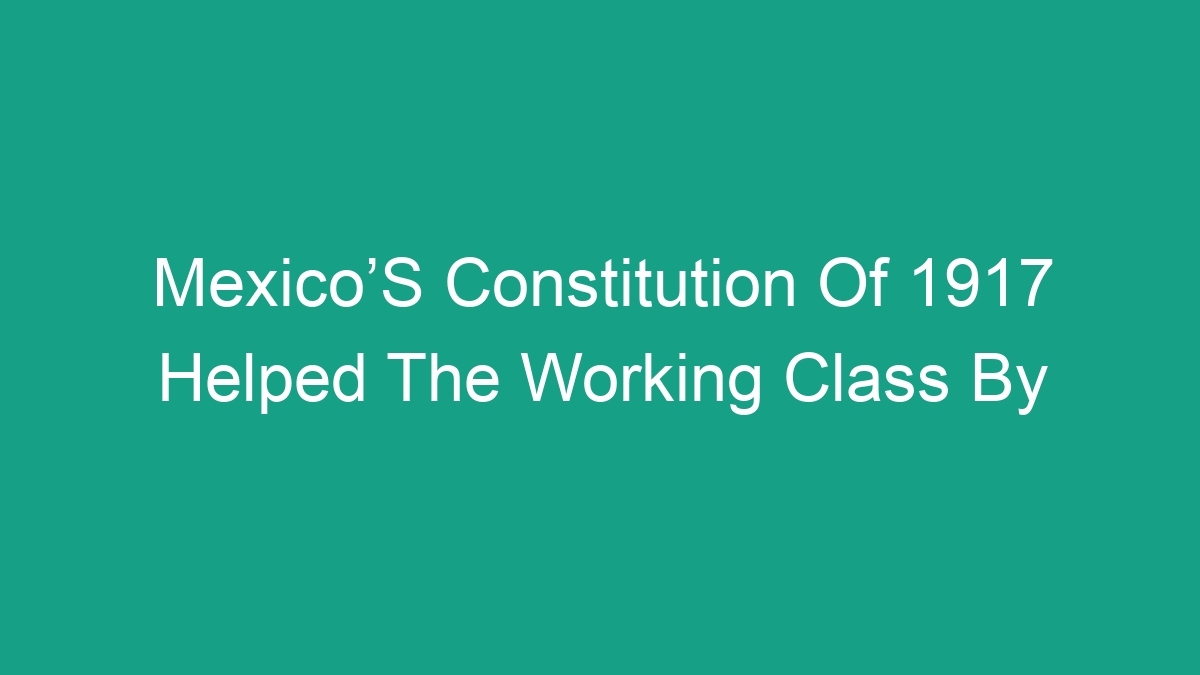
The Constitution of Mexico, also known as the Political Constitution of the United Mexican States, is the supreme law of the country. It was enacted on February 5, 1917, and has been amended several times since then, with the most recent major reforms occurring in 2019. The Constitution of 1917 is particularly noteworthy for its provisions aimed at protecting the rights of workers and improving their living and working conditions. In this article, we will explore the ways in which Mexicoʼs Constitution of 1917 helped the working class.
Recognizing the importance of labor rights
One of the key ways in which the Constitution of 1917 helped the working class was by recognizing the importance of labor rights. The constitution specifically includes articles that guarantee the rights of workers, including the right to form unions, the right to strike, and the right to a fair wage. These provisions were a response to the widespread exploitation of workers by powerful landowners and industrialists, and they were intended to empower workers and improve their bargaining power.
The constitution also established the right to an eight-hour workday, a weekly day of rest, and a decent living wage. These provisions were designed to ensure that workers were not overworked and that they were able to maintain a reasonable standard of living. Additionally, the constitution established the right to social security, including healthcare, pensions, and other benefits, to provide workers with a safety net in case of illness, injury, or old age.
Land reform and the protection of agricultural workers
In addition to its provisions for industrial workers, the Constitution of 1917 also included measures aimed at protecting agricultural workers. One of the most significant of these measures was land reform, which was intended to address the widespread inequality in land ownership that existed at the time. The constitution provided for the expropriation of large landholdings and their redistribution to landless peasants, in order to create a more equitable system of land ownership.
This land reform was a crucial step in improving the lives of agricultural workers, many of whom were living in poverty and struggling to make a living. By gaining access to land, these workers were able to increase their economic independence and improve their living standards. Additionally, the constitution included provisions for the protection of rural workers’ rights, including the right to a fair wage, the right to form unions, and the right to decent housing and working conditions.
Protecting workers from exploitation
Another important way in which the Constitution of 1917 helped the working class was by protecting workers from exploitation. The constitution included measures aimed at regulating working conditions and ensuring that workers were treated fairly by their employers. For example, it established the right to a safe and healthy workplace, and it prohibited the employment of children under the age of 14. These provisions were intended to prevent the kind of abusive working conditions that were common at the time, and to ensure that workers were able to work in a safe and dignified environment.
Additionally, the constitution included measures aimed at regulating the power of employers and ensuring that workers could effectively bargain for better conditions. For example, it prohibited monopolies and unfair business practices that could harm workers, and it established the right to strike as a means of collective bargaining. These measures helped to balance the power dynamics between workers and employers, and to ensure that workers were able to demand fair treatment and better wages.
Impact on the modern labor movement
The Constitution of 1917 had a lasting impact on the modern labor movement in Mexico. Its provisions laid the groundwork for the development of strong labor unions and a tradition of worker activism. The constitution’s recognition of the right to form unions and the right to strike provided workers with important tools for advancing their interests, and its provisions for social security and land reform helped to improve the living and working conditions of millions of workers across the country.
Today, Mexico has a vibrant labor movement with a long history of advocating for workers’ rights and pushing for progressive labor reforms. While there are still challenges facing workers in Mexico, including low wages, precarious employment, and weak enforcement of labor laws, the Constitution of 1917 continues to serve as a powerful tool for protecting workers and advancing their interests.
Conclusion
In conclusion, Mexicoʼs Constitution of 1917 played a crucial role in helping the working class by recognizing the importance of labor rights, protecting agricultural workers through land reform, and safeguarding workers from exploitation. Its provisions have had a lasting impact on the modern labor movement in Mexico and continue to serve as a foundation for advocating for workers’ rights. While there is still work to be done to further improve the conditions of workers in Mexico, the Constitution of 1917 remains a powerful tool for advancing the interests of the working class.
By recognizing the historical and ongoing significance of the Constitution of 1917 in protecting and empowering workers, we can ensure that its legacy continues to shape the future of labor rights in Mexico.




